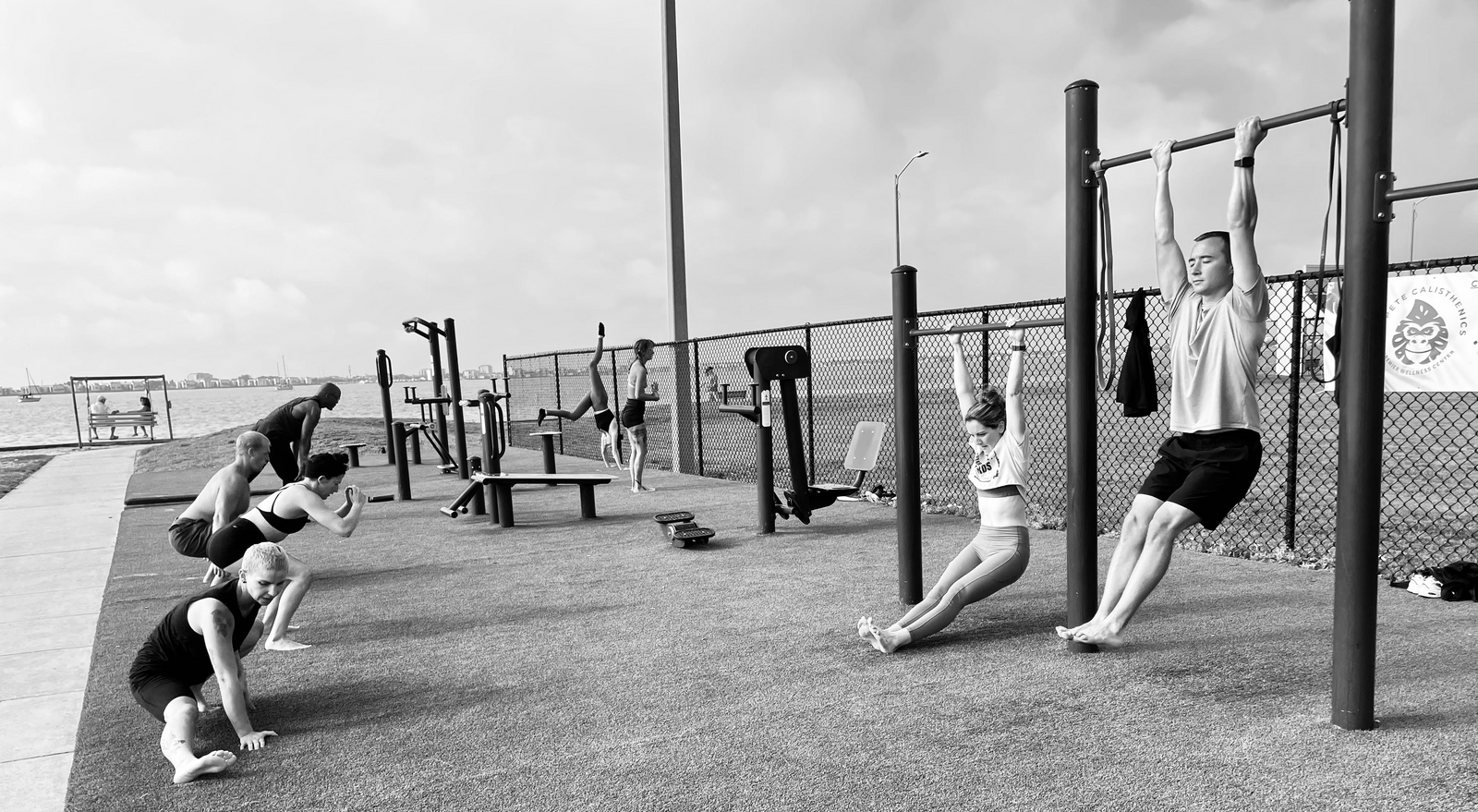Calisthenics vs. Your Standard Gym: Exploring the Differences

If you're a fitness enthusiast looking for a fresh and challenging workout experience, consider calisthenics. Calisthenics is a form of strength training that utilizes your body weight as resistance. It offers a unique approach to fitness that differs significantly from a standard gym routine.
Never heard of calisthenics and are reluctant to try something new? We got you. Here's everything you need to know about calisthenics and its advantages over a traditional gym experience.
Let's jump in!
What is Calisthenics?
Essentially, calisthenics is a form of exercise that uses body weight as resistance to build strength, flexibility, and endurance. It's a training method that can be practiced virtually anywhere without expensive equipment or gym memberships; you only need your body! Calisthenics exercises typically involve push-ups, squats, lunges, and core exercises.
Examples of Calisthenics Exercises:
- Push-ups (and variations like diamond push-ups, decline push-ups, and clapping push-ups)
- Flow movement with a steel mace
- Pull-ups and chin-ups
- Dips
- Animal flow movements
- Squats (and variations like jump squats, pistol squats, and squat holds)
- Lunges (forward, reverse, and lateral)
- Planks and core exercises (like leg raises, Russian twists and hollow body holds)
- Burpees
- Muscle-ups
What is Not Considered Calisthenics
Since calisthenics focuses on bodyweight exercises, it's easy to assume that some popular exercises, such as yoga, would be considered under the calisthenics umbrella. Unfortunately, an exercise that is primarily bodyweight-focused may not be calisthenics.
Here are the exercises not considered calisthenics and why:
- Weight Lifting: Any exercise that involves lifting external weights, such as barbells, dumbbells, kettlebells, or weight plates, is not considered a calisthenics exercise.
- Weight Machines: Exercises performed on weight machines, such as leg presses, chest presses, lat pulldowns, or cable machines, are not part of calisthenics training.
- Plyometric Exercises: While some plyometric exercises, such as box jumps or clapping push-ups, may be incorporated into calisthenics routines, the majority of plyometric exercises, such as depth jumps, bounding, or medicine ball throws, are not considered calisthenics exercises.
- Cardiovascular Exercises: Traditional cardio exercises like running, cycling, rowing, or using elliptical machines are not calisthenics exercises.
- Resistance Band Exercises: While resistance bands can be used as an additional tool in calisthenics training, exercises that rely solely on resistance bands are not considered true calisthenics exercises.
- Yoga or Pilates: While yoga and Pilates can complement a calisthenics routine by improving flexibility and core strength, they are distinct forms of exercise with their own principles and techniques.
It's important to note that while calisthenics focuses on bodyweight exercises, it can sometimes incorporate external resistance like weighted vests, dip belts, or ankle weights to increase the difficulty of certain movements. However, the core principle of calisthenics remains using one's body weight as the primary source of resistance.
Differences: Calisthenics Gym vs. Traditional Gym
Chain gyms like Planet Fitness and LA Fitness offer numerous benefits. Not only does their widespread accessibility make it convenient for members to get a workout anywhere, but they also offer almost every piece of workout equipment imaginable, from weight machines and free weights to cardio machines and sometimes even saunas and steam rooms.
Unfortunately, these attractive benefits are usually diminished by problems of overcrowding, lack of access, and a generally impersonal workout experience.
This is where calisthenics gyms shine. Because they focus on body-weight movements, equipment is relatively minimal, and space is abundant. This ensures everyone has the room, tools, and access to do whatever they'd like—always.
Here are the other main differences between a calisthenics gym and a traditional gym:
Equipment
Calisthenics gyms are designed with minimal equipment, focusing on bars, parallel bars, dip stations, and other structures allowing bodyweight exercises. Traditional gyms, on the other hand, are filled with weight machines, free weights, and cardio equipment.
Space Utilization
Calisthenics gyms often have open floor spaces and overhead bars, allowing for dynamic movements and efficient use of space. Traditional gyms have more dedicated areas for specific equipment.
Training Style
Calisthenics workouts are typically high-intensity and functional, emphasizing full-body movements and core strength. Traditional gym workouts can be more isolated and focused on specific muscle groups.
Skill Development
Calisthenics often incorporates advanced techniques like muscle-ups, levers, and handstand push-ups, which require significant skill development. Traditional gym workouts may focus more on lifting heavier weights or using machines.
Community
Calisthenics gyms foster a strong sense of community, with members encouraging and motivating each other. Traditional gyms can sometimes feel more individual-focused.
Versatility
Calisthenics exercises can be performed anywhere, making them highly versatile and convenient. Traditional gym workouts are often limited to the equipment available at the facility.
Cost
Calisthenics gyms typically have lower membership fees compared to traditional gyms, as they require less overhead and equipment maintenance.
Whether you're a seasoned fitness enthusiast or just starting your fitness journey, calisthenics offers a unique and challenging approach to strength training. By embracing bodyweight exercises and the calisthenics philosophy, you can achieve a well-rounded fitness level while enjoying the camaraderie and minimalistic environment of a dedicated calisthenics gym.
When to Try a Calisthenics Gym
If you've been going to traditional gyms for years and you're craving a new experience, this could be your sign to try calisthenics. Calisthenics gyms offer members a chance to break free from equipment-based workouts and tap into their own bodies to hone in on particular skills. It's a time to play, explore, and build strength while you do.
At St. Pete Calisthenics, our mission is to create a sense of community utilizing the best fitness tool available to everyone: your body.
Visit our website or contact us today at (727) 253-7018 for a free first calisthenics class for new members. Plus, during our Founders Rate Presale, you can get a discounted rate on our Premier Membership.



